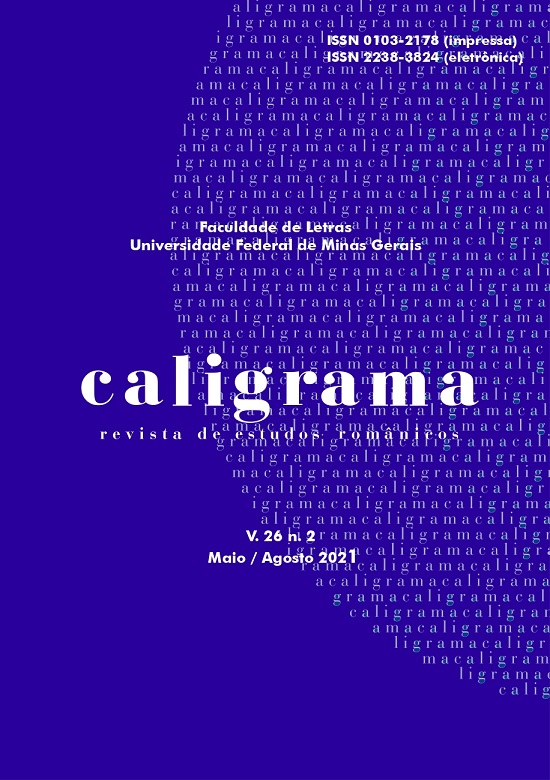Analyzing Lexical Boost Effects in Priming of the Passive in Brazilian Portuguese
DOI:
https://doi.org/10.17851/2238-3824.26.2.29-46Palavras-chave:
lexical boost, structural priming, passive construction, image description taskResumo
The lexical boost effect is an increase in the magnitude of structural priming effects when prime and target verbs are identical. This study investigates the connection of lexical boost to priming effects of the passive construction in Brazilian Portuguese (BP) in an image description task to contribute to the debate about whether lexical boost effects are a result of surface word repetition or a connection between the lexical item in the working memory and the structure in long-term memory. The task measured subjects’ working memory (WM) capacity and manipulated task protocol by adding a matching cover task to the picture description task. Data collected indicate that structural priming effects in the image description task were contingent on lexical identity, presenting a positive correlation with choice of structure in the description. WM capacity did not influence priming effects, nor did subjects’ performance in the cover task. Results provide evidence in favor of lexical boost effects being a result of residual activation of the connection between lexical item and structure. They also provide insight about the task and its applicability to priming effects of the passive construction in BP.
Referências
ANIMAKER. Palo Alto: Animaker, c2021. Online software. Available
at: http://animaker.com. Access on: Mar. 1st, 2021.
BADDELEY, A. Working Memory: Looking Back and Looking Forward.
Nature Reviews: Neuroscience, 4, p. 829-839, 2003.
BERNOLET, S.; COLLINA, S.; HARTSUIKER, R. J. The persistence
of structural priming revisited. Journal of Memory and Language, 91,
-116, 2016.
BOCK, J. K. Syntactic persistence in language production. Cognitive
Psychology, 18, 355-387, 1986.
BOCK, J. K.; GRIFFIN, Z. M. The Persistence of Structural Priming:
Transient Activation or Implicit Learning? Journal of Experimental
Psychology: General, 129(2), 177-192, 2000.
CAMACHO, R. G. Em Defesa da Categoria de Voz Média no Português.
D.E.L.T.A., 19(1), p. 91-122, 2003.
CHANG, F.; DELL, G. S.; BOCK, J. K. Becoming Syntactic.
Psychological Review, 113(2), 234-272, 2006.
CHANG, F.; DELL, G. S.; BOCK, J. K.; GRIFFIN, Z. M. Structural
Priming as Implicit Learning: A Comparison of Models of Sentence
Production. Journal of Psycholinguistic Research, 29(2), 217-229, 2000.
DRUMMOND, A. Ibex Farm, 2016. Available at http://spellout.net/
ibexfarm/. Accessed on March 1st, 2021.
ELLIS, N. C. Constructions, Chunking and Connectionism: The
Emergence of Second Language Structure. In: DOWTY, C. J.; LONG,
M. H. (Ed.). The Handbook of Second Language Acquisition. Malden,
MA: Blackwell, 63-103, 2003.
GUIMARÃES, M. P. Structural persistence and surprisal: implications
for proficiency-modulated distributional learning in late bilinguals. 2018.
Caligrama, Belo Horizonte, v. 26, n. 2, p. 29-46, 2021
p. Unpublished PhD dissertation (Linguistics) – Programa de PósGraduação em Estudos Linguísticos, Belo Horizonte, 2018.
GUIMARÃES, M. P. Frequency effects of L2 English on the processing of
the passive in L1 Brazilian Portuguese. Revista de Estudos da Linguagem,
v. 29, n. 1, p. 215-258, 2021.
JAEGER, T. F.; SNIDER, N. Alignment as a consequence of expectation
adaptation: Structural priming is affected by the prime’s prediction error
given both prior and recent experience. Cognition, 127, 57-83, 2013.
KASCHAK, M. P.; KUTTA, T. J.; JONES, J. L. Structural priming as
implicit learning: Cumulative priming effects and individual differences.
Psychonomic Bulletin and Review, 18, p. 1133–1139, 2011.
KLAUS, J.; SCHRIEFERS, H. (2016). Measuring working memory
capacity: A reading span task for laboratory and web-based use.
Unpublished manuscript submitted for publication.
LEVELT, W. J. M.; ROELOFS, A.; MEYER, A. S. A theory of lexical access
in speech production. Behavioral and Brain Sciences, 22, 1(75), 1999.
LOWDER, M. W.; GORDON, P. C. Natural Forces as Agents:
Reconceptualizing the Animate-Inanimate Distinction. Cognition, 136,
p. 85-90, 2015.
MALHOTRA, G.; PICKERING, M. J.; BRANIGAN, H., & BEDNAR,
J. A. On the persistence of structural priming: Mechanisms of decay and
influence of word-forms. In LOVE, B. C.; MCRAE, K.; SLOUTSKY,
V. M. (Ed.). Proceedings of the 30th annual conference of the cognitive
science society, 657-662. Austin: Cognitive Science Society, 2008.
R CORE TEAM. R: A language and environment for statistical
computing. R Foundation for Statistical Computing, Vienna, Austria.
Available at https://www.R-project.org/. Accessed on March 1st, 2021.
PICKERING, M. J.; BRANIGAN, H. P. The Representation of Verbs:
Evidence from Structural priming in Language Production. Journal of
Memory and Language, 39, 633-651, 1998.
TOOLEY, K. M. Contrasting mechanistic accounts of the lexical boost.
Memory and Cognition, 48, p. 815-838, 2020.





